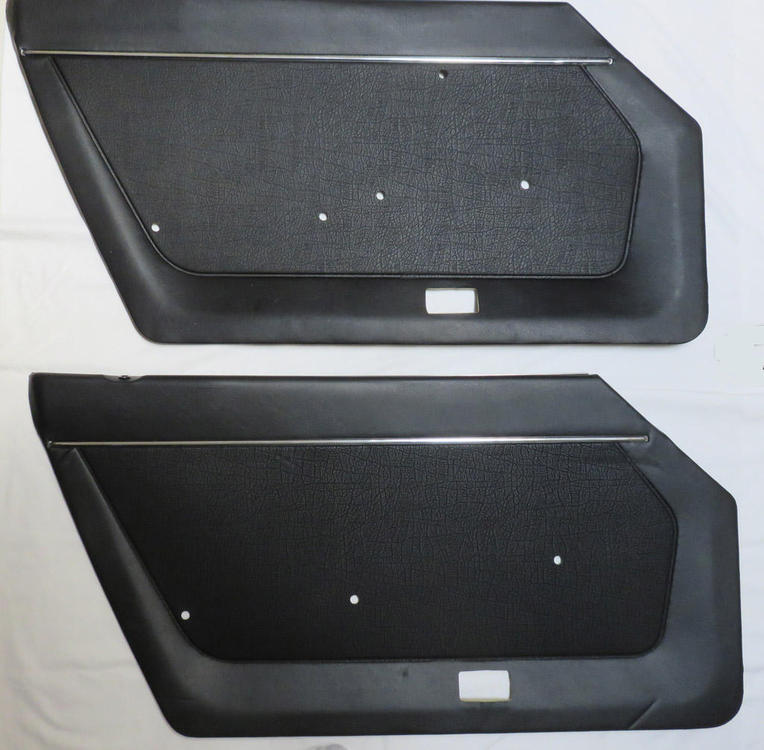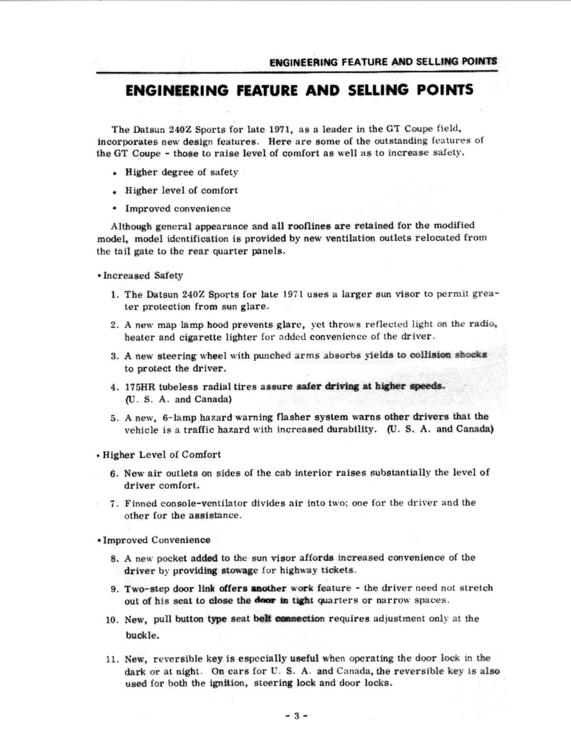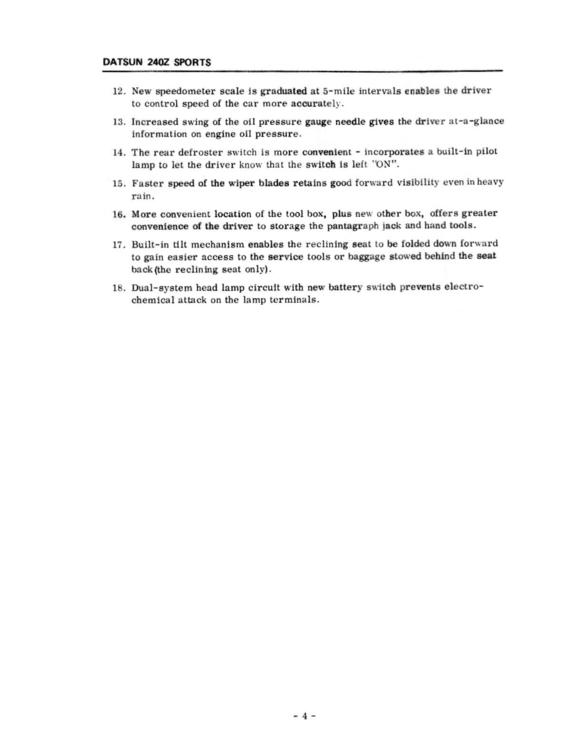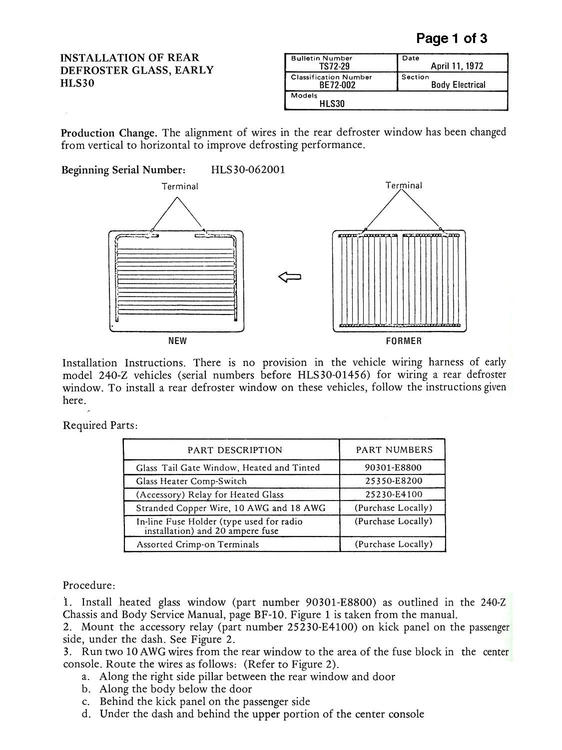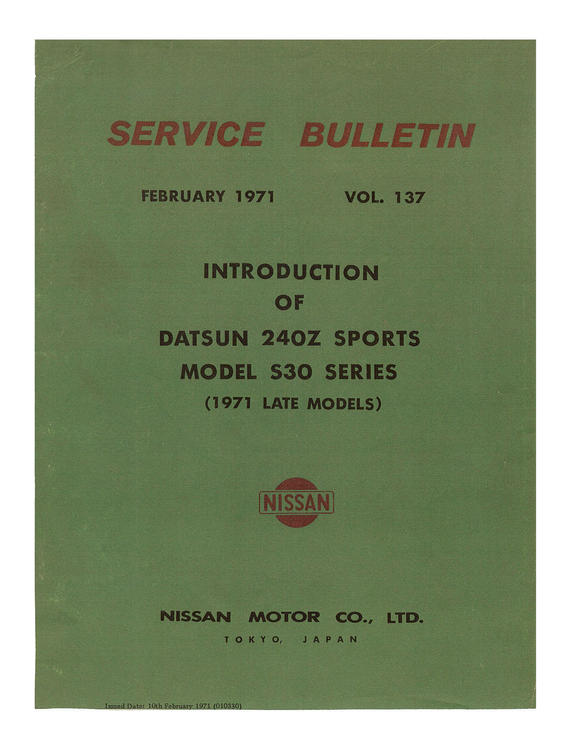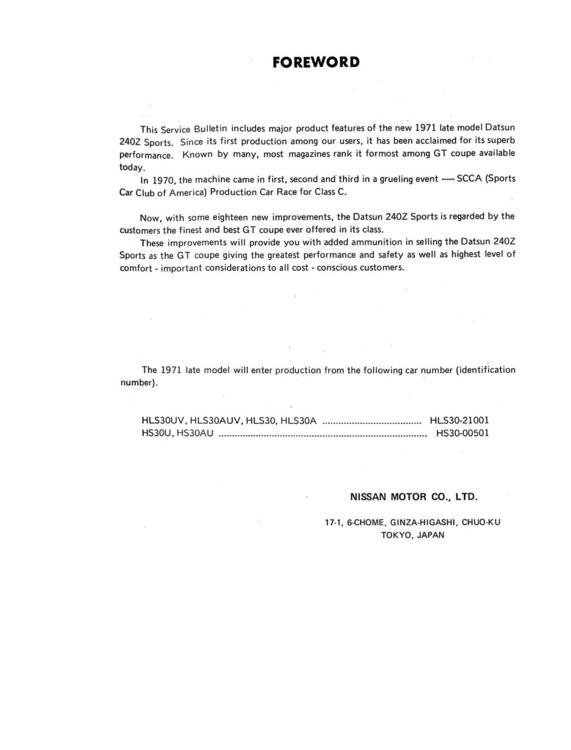Everything posted by Carl Beck
-
Refurbished 1970 240Z Sells for $77,240 on BaT
There are a couple elements that need to be distinctly identified. a) the compressed fiber door panel and b) the vinyl covering. I take it that you are talking about the holes in vinyl covering - Y/N? The difference between the later left side door panel - on the Left Hand or Right Hand Drive models - was the pre-cut holes in the vinyl. (see picture below). As far as I can remember - the original early fiber door panels for the Left Hand Drive Z’s did not have the holes in the fiber door panel backing necessary to mount the Passenger Assist Straps on the Drivers Door. That was changed some time later. Will see if I can find or get some pictures. My guess related to why the Passenger Assist Strap is on the subject $77K example - The Seller said it was a 10 year project - he most likely ordered the correct part number for the Left Hand Drive model, but received a replacement meant for use on a Right Hand Drive model. On these the black vinyl had holes pre-cut for the Pass.Asst.Strap - and the only way to cover it was to install the Strap. This happened to several of us back in the late 90’s and early 2000’s. When i received the wrong panels - I notified Courtesy Nissan and they replaced them for me with the correct parts.
-
To buy or not to buy...that is the question
- New Z Owner
I believe you are correct..Ground the positive wire at the gas tank - the gauge should swing to FULL.. If it doesn’t its the gauge - if it does its the sending unit, or a broken wire. Your Agreed Value is WAY to low today. It should be closer to $40K. Even then it would take a long time to find a replacement at that price.- Repro 240Z Fuel Tank Coming Available
@madcow See: http://zhome.com/Racing/FuelTankVaporLineMod/FuelTankVaporMod.htm- GMB mechanical fuel pump failures
Thanks forechecking in - we want to send them some of the failed pumps, so they can determine for themselves what the problem is. (it's a corporate thing...LOL). I have 3 new one's myself I bought as future "donors".- ZHome.com gone?
Hi Guys - looks like "The Z Car Home Page" at ZHome.com is back on-line now.. thanks, Carl- GMB mechanical fuel pump failures
Hi Guys: Thanks for the replies. I was aware of @zKars Posts and several other discussions here on the subject. When I initially contacted GMB about the issue, I gave them a brief summary from the Customers perspective along with hyper-links to several on-line discussions, 3 from the Classic Z Car Club’s forum. I also included links to the reviews from Amazon.com It seems from the Amazon Reviews - that they have been selling this pump since 2015. The Reviews on Amazon seem to be 5 Star in the 2015 to 2018 period, but then from 2018 to today they were getting 1 Star reviews. No one I could find had contacted them about their faulty product - so I thought it might be good to contact them and see what if anything they would do about it. I think all of us were happy GMB was providing a mechanical pump that “looked right”, and perhaps we all expected it to perform at least close to the OEM units in terms of reliability. I was hoping that once directly notified, GMB would address / correct the issue, and provide us with a pump that could be used for more than just donor parts.- GMB mechanical fuel pump failures
GMB 550-8040 Fuel Pump Failures: I have contacted and am now working with GMB of North America; in an attempt to identify the issue of infant mortality aka premature failure on their mechanical fuel pumps for our Z's. The issue has been widely discussed over the past couple years on different Z Car Forums and Face Book Pages. GMB Product Management has ask me if we could return 3 or 4 of these failed fuel pumps directly to them, so they can attempt to identify the problem. If you have kept one of these pumps that failed, would you be willing to package it up and return it directly to either me, or them? If so please contact me directly and we will work out the details - In addition to a response here - an Email would be best as it is most direct and easy to file/track. Email: beck@becksystems.com Please Put "GMB Fuel Pump" in the Subject Line- ZHome.com gone?
Thanks for the heads-up - - Small issue with the LAN - should be back on-line by end of day.- Clutch Issue
Your Clutch Disc is most likely rusted and stuck to the flywheel. Put it out of gear and start the engine, warm it up and charge the battery. After its warmed up shut it off. Push the car out on the street, put it in 1st gear and start the engine (with the car in gear). Get it rolling about 15 to 20 mph - push the clutch pedal to the floor, at the same time you give it some gas and pull the Emergency Brake HARD! (to stop the rear wheels from turning - while keeping the engine running). That should break the clutch disc free of the flywheel. Might have to do it a couple times. When it breaks free you'll feel the clutch pedal regain some resistance (feel normal).- New owner
The Black Pearl Metallic Paint was a $90.00 option on the 78 280Z. The Sports or Special Appearance Package was a second additional $199.00 option. See: http://zhome.com/History/BlackP.htm- New owner
Looks like it might be a Black Pearl...did you get any original documentation with the Z?- Early vs. Late Series I 240Z's
@Randalla Where Weaker is Better: New US Federal Motor Vehicle Safety Standards (FMVSS) were issued and put into force for all Vehicles Manufactured on or after March 1971 to be sold in the USA. One of them specified the amount of force at which the steering wheels had to break-away or yield. It was intended to lower the number of broken wrists and arms - when Drivers were thrown against the steering wheel. Much the same as earlier specifications applied to the collapsable steering column requirements. To meet that standard, the original design steering wheel had to weakened and it was done by punching out the former indents in the steel. Figuring out how to meet that new standard most economically; and putting it into production - was one reason the Series II 240Z’s had to be put into production by or before March of 1971. So the weaker and safer steering wheel started with the Series II cars at HLS30 21001.- Early vs. Late Series I 240Z's
@Randalla Sorry I had to be away from this for a few days - but getting back to your original Post. The 2400 Valve Covers were used on all 240Z’s arriving here produced up until the first 240Z’s with A/T started to arrive. The 240Z’s with A/T that we saw at the time, came though with the OHC valve covers, and soon that followed on the manual shift cars. I do not believe we ever pinned it down factually to a specific VIN range - - but that was on cars produced in 08/71 and VIN ranges around 8000. If some original owner had a 240Z produced in 09/70 with a 2400cc valve cover in the 9000 VIN range it wouldn’t surprise me - but I seriously doubt we received more than 9000 or 10,000 2400 cc valve covers - and that is why today they sell for $450.00+.- Early vs. Late Series I 240Z's
Throw them out or use them? You are pulling our leg! Auto Manufacturers warehouse massive inventories of NOS Parts, to supply their Dealers and Customers with repair and replacement parts for years into the future. It is a huge Profit Center. Among all of them I’ve ever dealt with - Nissan supplied NOS parts far longer than anyone else - 25+ years after initial production you could get just about anything over the Nissan Dealer Parts Counter. Silly to think that the production/assembly lines would be faced with using up left over parts, or that they would start production of a new model without having all the necessary parts needed to feed an assemble line. Granted that we did see a few “mistakes” at the very end or very beginning - but what we see today on 50 year old examples passing though unknown numbers of previous owners is really proof of nothing. If the 260Z was a hodgepodge - the reason was ever and quickly changing US EPA, DOT-FMVSS standards at the time. All the auto manufacturers selling vehicle in the USA had to deal with that situation; and I think Nissan did a admiral job. Especially considering the very low production numbers of the Z Cars; by US standards any production vehicle selling less than 100K units per year is almost a limited production example. Ford sold 385,993 Mustang II’s in 1974, Chevy sold 151,000 Camaro’s in 74 where Datsun sold about 150K units in Four Years!.- Early vs. Late Series I 240Z's
According to Nissan, some 18 new improvements were incorporated into the 1971 LATE MODELS - aka Series II - the second series of chassis serial numbers starting at HLS30 21001 and HS30 00501. All 18 of these improvements were made at the Model Change Over.- Early vs. Late Series I 240Z's
- Mint '71 240Z - More Fun Coming to BaT
As the sticker says - "Vehicle Emission Control Information”- - it is not a performance spec. Customers that wanted a performance tune knew what to do. Still in several States they had to pass annual vehicle emissions tests to keep their cars registered for road use. Customers in the USA wanted cleaner air and the largest Customer Base that was almost fanatics about it was in California; where some 20,000,000 people were choking on pollution almost monthly. California lead the demand for the reduction of automotive exhaust gas pollution, with their California Air Research Board setting State Level Standards, restricting exhaust gas pollution and gasoline vapor pollution over and above the USA Federal Standards which were the strictest enforced in the world. So for daily driving a Sports/GT Customers were more than happy to give up a couple HP for cleaner air; especially in a car where losing a couple HP wouldn’t even be noticed in day to day traffic.- Mint '71 240Z - More Fun Coming to BaT
Chris, I'd say they were five digit serial number up to 100000 - - HLS30 100095 had a date of Mfg. of 08/72 and the highest VIN for a 72 Model we have found so far is #101398 in Portugal.- Mint '71 240Z - More Fun Coming to BaT
While the Date Range is wrong - the chassis serial number ranges are correct according to the Service Bulletins.- Mint '71 240Z - More Fun Coming to BaT
I certainly did not coin the term - I’m not that OLD! The use of Series designations to distinguish one model from another of various Marques, when confusion existed because of terms like “Model Year” - has been around and in use among auto enthusiast since I can remember. The E-Type’s for example used Series I & 2 when both models were sold with the same Model Year designation back in the early 60’s. (Some say Flat Floors) So nothing new there. Series designations were applied to the Datsun 240Z’s by enthusiasts not to long after Nissan sold the same model as both 1970 & 1971 Model Year vehicles, long before the Internet. We know there is a large overlap in the Registrations and Titles of 1970 &1971 Model Year examples. The first, second, third and fourth Series of Chassis Serial Numbers for Datsun 240Z’s are all specifically identified by Nissan in their Technical Service Bulletins. There are four specific VIN number series used to identify them.(one VIN series for Left Hand Drive and another VIN series for Right Hand Drive). Nissan issued Technical Service Bullets listing the beginning VIN chassis serial number series (Vehicle Information + Chassis Serial Numbers) as well as what Nissan considered major improvements to Safety, Comfort and Convenience of each - all introduced at the same time on the subsequent series. For HLS30 models: The First Series of Chassis Serial Numbers Sold to the Public - VIN’s HLS30 00013 The Second Series of Chassis Serial Numbers - VIN’s HLS30 21001 The Third Series of Chassis Serial Numbers - VIN’s HLS30 46000 The Fourth Series of Chassis Serial Numbers - VIN HLS30-120001 For HS30 models The First Series of Chassis Serial Numbers Sold to the Public started with HS30 00003 (from Oct.69) The Second Series of Chassis Serial Numbers - HS30 00501(from Jan 71) The Third Series of Chassis Serial Numbers - HS30 01501 (from Sep. 71) The Fourth Series of Chassis Serial Numbers - HS30 14001 (from July 72) Nissan listed some 17 or 18 specific Safety, Comfort and Convenience Features introduced on the Second Series of HLS30 production for North America, starting with VIN HLS30 21001 . These were not changes to minor parts during the production run, nor changes to part numbers made throughout the calendar year. These were improvements you got for buying the New & Improved Model being released and not found on the earlier one. See: SERVICE BULLETIN, February 1971, Vol. 137 INTRODUCTION OF DATSUN 240Z SPORTS MODEL S30 SERIES” (1971 Late Models) Likewise the New Model Introduction - Technical Service Bulletins - issued by Nissan list the significant changes for the third and fourth Series of production. Several of these Nissan Technical Service Manuals are now available in digital form on line.- I've been looking for a project
About the plastic guide rollers on the ends of the lift arms - A friend of mine took his regulators to a local Machine Shop - they removed the original rivets and found plastic guide rollers that would work -then riveted the new one’s back on. You could also use a bolt on type - just cut the bolt off and spot weld.. Something like these… https://www.mcmaster.com/track-rollers With 50 year old cars - sometimes you just have to make the part.. good luck, Carl- I've been looking for a project
Most of the time - the problem with windows rolling up/down are caused by the felt pads and seals in the window door frames. You have to take the door apart - pull the window frames out - and replace the felt and rubber seals. Many times the plastic rollers on the window lift will be gone as well.. but cleaning and new grease will solve most problems.- I've been looking for a project
Fresh Tires close to the original size will work wonders for both ride and handling. 195/70x14's - 205/60x15's will work, but steering is a little harder and wider tires tend to "track" or follow the road more. Very important to assure you have good bushings in the Tension/Compression rods. KYBs are good if you can still get them, Tokico gas pressures are fine as well. Stock spring rates are fine, a slightly larger diameter front anti-sway bar improves handling without having too much effect on ride quality.- 2019 ZCCA Branson
Just an FYI - - https://www.wsj.com/articles/when-datsun-met-corvette-sparks-flew-11569942100 Carl B. - New Z Owner
Important Information
By using this site, you agree to our Privacy Policy and Guidelines. We have placed cookies on your device to help make this website better. You can adjust your cookie settings, otherwise we'll assume you're okay to continue.




